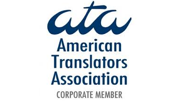Get a Free Quote
Our Accreditations





Recent Updates
Buckets and spoons: an etymological tour of death metaphors
The need to translate English into English is more common than you might imagine, where phrases of English are deployed in a foreign language and have taken on an alternative meaning that isn’t appropriate in actual English text. Read More
| What translation technology does Rosetta Translation use? | We use the most sophisticated translation memory and data mining tools. More . |
| How do Rosetta’s translation memory tools work? | They ‘remember’ translations of segments for efficient future use. More . |
| How do Rosetta’s data mining tools work? | They allow database storage and use of previously created material. More . |
| How is this technology integrated into the Rosetta workflow? | With the client’s permission, we create a designated terminology database at the time of the first translation. All subsequent work expands and embeds this database further. More . |
| How does my organisation benefit in the long term? | Our clients’ main benefits are reduced revision time, increased textual consistency and direct cost savings. More . |
Rosetta Translation uses the most state-of-the-art CAT (Computer Assisted Translation) tools to serve our customers. We mainly use:
Translation memory tools store "segments" of text in a memory as the translator translates them. If a segment reoccurs elsewhere in the text, the translator can summon its previous translation from the memory instead of having to re-translate or search for the segment in question. If a segment similar to a previous one occurs, the translator can summon a partial (or "fuzzy") match from the memory for editing.
Translation memory tools should not be confused with ‘machine translation’. The latter is produced entirely by computers. Their output quality is generally poor, and can at best be used as draft material, if at all.
They extract a list of candidate terms and probable translations from previously translated materials. Approved terms can then be transferred on-the-fly to a client-specific database to be edited and approved by a terminologist or domain expert.
At the time of the first translation assignment for a particular client, an initial client-specific ‘translation memory’ is created. It can be based solely on the actual translation being created, but it benefits greatly from being supplemented by
For each subsequent assignment for the same client, the client’s translation memory is then used to translate additional documents. In the process, the translation memory extends and becomes more robust and reliable.
At the end of each assignment, critical terms (e.g. terms that may be specific to the client) are double-checked with the client to ensure that our translation memory is as complete and accurate as possible. Our experience shows that best results are obtained in an active dialogue with designated client experts.
All client data remains of course subject to our confidentiality agreement, and client databases are only ever used for subsequent assignments for the same client. The only exception is where texts and translations are in the public domain and explicit client permission has been obtained.
Our clients benefit greatly from this seamless integration of the latest technology, through:
Get a Free Quote
© 2024 All Rights Reserved
Rosetta Translation, 133 Whitechapel High St, London E1 7QA · 0207 248 2905